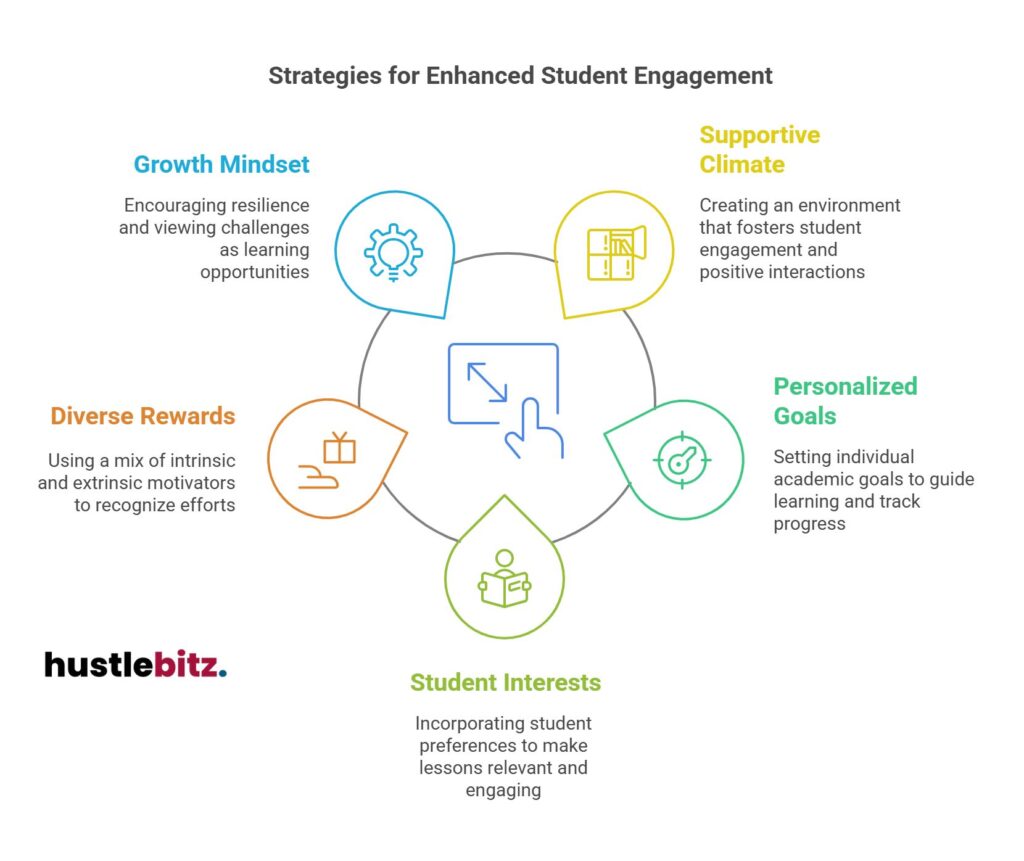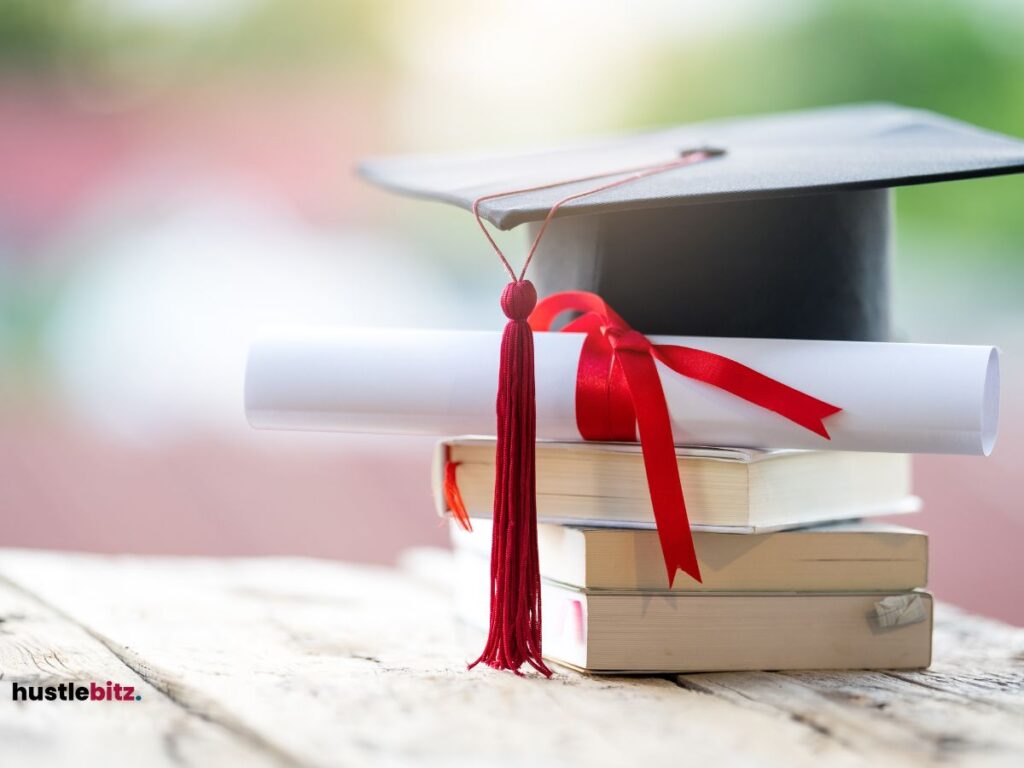Effective student motivation techniques are crucial for academic success. Begin by understanding the factors that drive motivation, including intrinsic and extrinsic elements. Setting clear goals—both short-term and long-term—helps students stay focused. Creating an engaging learning environment, incorporating student interests, and employing positive reward systems can further enhance motivation. Fostering a growth mindset allows students to view challenges as opportunities for growth. Additionally, promoting self-efficacy through reflection and mentorship reinforces their belief in success. Lastly, developing positive study habits lays the foundation for sustained motivation. Discover more strategies to enhance academic engagement and achievement.
Key Takeaways
- Foster intrinsic motivation by creating a supportive classroom climate that encourages student engagement and positive peer interactions.
- Set clear, personalized academic goals to guide students in their learning journey and track their progress effectively.
- Incorporate student interests into lessons to enhance relevance and engagement, allowing for choice and autonomy in learning activities.
- Utilize diverse reward systems that combine intrinsic and extrinsic motivators, ensuring timely recognition of student efforts and achievements.
- Promote a growth mindset by encouraging resilience, viewing challenges as learning opportunities, and providing constructive feedback for continuous improvement.

Understanding Student Motivation Factors
A comprehensive understanding of the various factors influencing student motivation is essential for fostering an engaging and effective learning environment.
Intrinsic motivation, driven by personal interest and satisfaction, plays a crucial role in enhancing student engagement. Conversely, extrinsic motivation, which stems from external rewards or recognition, can also influence student behavior, albeit in a different manner. Motivation theories, such as the Self-Determination Theory, emphasize the importance of autonomy, competence, and relatedness in nurturing intrinsic motivation.
The motivational climate within a classroom significantly impacts student motivation. A positive climate, characterized by supportive teacher interactions and collaborative peer relationships, can enhance motivation levels. Peer influence is particularly relevant, as students often look to their classmates for validation and encouragement. Furthermore, cultural factors can shape motivation, as different cultural backgrounds may prioritize various educational values and expectations.
Teacher support is paramount in creating a conducive motivational environment. Engaged and empathetic educators can inspire and nurture students’ intrinsic motivation, while their feedback can validate students’ efforts and achievements. Additionally, parental involvement is fundamental; supportive parents who encourage academic pursuits can bolster a student’s motivation to succeed.
To better understand and assess these motivational factors, educators can implement motivation assessments. Such tools can provide insights into students’ motivational levels, guiding teachers in tailoring their instructional strategies to meet diverse needs.
Setting Clear Academic Goals

Setting clear academic goals is essential for guiding students’ focus and enhancing their motivation throughout the learning process.
Effective goal setting allows students to outline personalized objectives that align with their aspirations for academic achievement. By establishing both short-term and long-term goals, learners can create a structured pathway that leads to their desired outcomes.
Short-term goals, such as completing assignments on time or achieving specific grades in tests, serve as immediate benchmarks. These measurable milestones contribute to a greater long-term vision, facilitating a sense of purpose and direction.
When students visualize their goals, they can better understand the steps required to reach them, which enhances intrinsic motivation. Moreover, goal visualization aids in fostering student accountability.
By regularly tracking their progress, students become more aware of their efforts, allowing them to adjust their strategies as necessary. This practice not only reinforces their commitment to their objectives but also instills a sense of ownership over their academic journey.
To further support this process, educators can encourage students to reflect on their goals and celebrate their achievements, no matter how small.
This reflection reinforces the importance of progress tracking and helps students appreciate their growth over time.
Ultimately, by setting clear academic goals, students can cultivate a motivated mindset that empowers them to strive for excellence and attain their full potential in an educational setting.
Creating an Engaging Learning Environment

Creating an engaging learning environment is crucial for fostering student motivation and enhancing their overall academic experience. An engaging atmosphere not only captivates students’ attention but also promotes active participation, critical thinking, and a sense of belonging.
To establish such an environment, educators can employ a variety of strategies that cater to diverse learning preferences and backgrounds. Key elements of an engaging learning environment include:
- Interactive classroom dynamics: Encourage discussions and debates that promote student voices.
- Sensory learning experiences: Utilize materials and activities that stimulate multiple senses, enhancing retention and comprehension.
- Collaborative project opportunities: Foster teamwork through group projects that allow students to share ideas and learn from one another.
- Flexible seating arrangements: Create spaces that accommodate different learning styles, enabling comfort and focus.
- Technology integration strategies: Utilize digital tools to enrich lessons and connect students with real-world applications.
Incorporating diverse teaching methods, such as peer feedback sessions and wellness-focused activities, can also enhance engagement. Ensuring cultural relevance in the curriculum allows students to see themselves reflected in their studies, making learning more meaningful.
By integrating these strategies, educators can create a dynamic learning environment that not only motivates students but also equips them with the skills necessary for academic success and lifelong learning.
Ultimately, fostering an engaging learning atmosphere is essential for nurturing a generation of motivated, well-rounded individuals ready to tackle future challenges.
Incorporating Student Interests

Incorporating student interests into the curriculum significantly enhances motivation and engagement, as learners are more likely to invest themselves in content that resonates with their personal passions and experiences. By recognizing and integrating these interests, educators can foster an environment where students feel a sense of choice autonomy and personal relevance, ultimately leading to deeper learning.
One effective strategy is to design collaborative projects that allow students to explore their passions while working alongside peers. This not only strengthens real-world connections but also promotes creative expression and critical thinking. Additionally, technology integration can facilitate interdisciplinary learning, enabling students to draw from various subject areas and apply their knowledge in authentic contexts.
Below is a table that highlights various ways to incorporate student interests into the learning experience:
| Strategy | Benefits | Examples |
| Collaborative Projects | Fosters teamwork and creativity | Group presentations on tech |
| Technology Integration | Engages digital natives | Using apps for research |
| Interdisciplinary Learning | Connects knowledge across fields | Math in music composition |
| Student Feedback | Enhances ownership of learning | Surveys on topic relevance |
Effective Reward Systems
Implementing effective reward systems can significantly enhance student motivation by reinforcing positive behaviors and academic achievements. A well-structured reward system not only acknowledges a student’s hard work but also encourages continued effort and improvement. By incorporating a variety of rewards, educators can cater to diverse student preferences and increase engagement.
To create an impactful reward system, consider the following strategies:
- Reward Diversity: Utilize both intrinsic rewards, such as personal satisfaction and mastery, and extrinsic rewards, like tangible prizes, to cater to different motivational drivers.
- Immediate Feedback: Provide prompt recognition for achievements, fostering an understanding of the connection between effort and reward.
- Social Recognition: Celebrate accomplishments publicly, enhancing students’ sense of belonging and motivation through peer acknowledgment.
- Personalized Rewards: Tailor rewards to individual student interests and needs, ensuring that each student feels valued and understood.
- Gamification Strategies: Incorporate elements like achievement badges and level-ups to motivate students through playful competition and goal-setting.
Additionally, maintaining an appropriate reward frequency is vital; consistent and timely rewards can strengthen the connection between effort and achievement. Academic incentives should be carefully balanced to promote intrinsic motivation while still providing sufficient external acknowledgment.
Fostering a Growth Mindset

Emphasizing the importance of resilience and effort, fostering a growth mindset encourages students to view challenges as opportunities for learning and development. This mindset shift is pivotal for academic success, as it empowers students to embrace failures as essential components of the learning process. The growth mindset benefits students by instilling a sense of intrinsic motivation, which drives them to overcome challenges and persist through difficulties.
By promoting resilience development, educators can guide students to understand that intelligence and abilities are not fixed traits but can be cultivated through dedication and hard work. The importance of feedback in this context cannot be overstated; constructive criticism becomes a valuable tool for adaptive learning, allowing students to refine their strategies and enhance their performance.
Peer collaboration also plays a significant role in fostering a growth mindset. Working with peers not only encourages diverse perspectives but also reinforces the idea that learning is a communal journey. This collaborative atmosphere nurtures a culture of support where students can share their experiences of overcoming obstacles, further solidifying their commitment to lifelong learning.
Ultimately, embracing a growth mindset leads to profound mindset shifts that prepare students for future challenges. By cultivating this perspective, educators can equip students with the resilience necessary to navigate both academic and personal pursuits, ensuring that they are well-prepared for the complexities of an ever-changing world.
Building Student Self-Efficacy

Building student self-efficacy is crucial for fostering an environment where learners feel confident in their abilities to succeed and tackle academic challenges. When students believe in their capacity to achieve, they are more likely to engage in effective self-assessment strategies and embrace personal challenges. This confidence can be cultivated through various techniques that encourage skill mastery and intrinsic rewards.
Implementing structured activities can significantly enhance self-efficacy. Consider the following approaches:
- Goal Visualization: Encourage students to visualize their goals and the steps needed to achieve them, reinforcing their belief in success.
- Reflection Journals: Promote regular journaling to help students reflect on their progress, challenges faced, and lessons learned, fostering a growth mindset.
- Peer Feedback: Facilitate opportunities for students to give and receive constructive feedback, enhancing their sense of community and shared learning.
- Mentorship Programs: Pair students with mentors who can provide guidance, support, and encouragement, helping them navigate academic challenges.
- Progress Tracking: Implement systems for tracking academic progress, allowing students to see their improvements over time and build confidence.
Encouraging Self-Motivation Strategies

To foster self-motivation in students, it is essential to provide them with strategies that empower them to take ownership of their learning journey. Implementing self-reflection activities allows students to assess their progress and identify areas for improvement. Intrinsic motivation techniques, such as goal visualization exercises, help students connect their aspirations with their daily efforts, fostering a sense of purpose.
Moreover, creating peer motivation partnerships can enhance accountability by encouraging students to support one another. Accountability groups further reinforce this concept, as they foster a shared commitment to academic goals. Providing motivation-enhancing feedback is crucial, as it encourages students to recognize their achievements and areas for growth.
Incorporating autonomy-supportive practices gives students the freedom to make choices in their learning, promoting engagement and self-direction. Emotion regulation strategies and mindfulness practices can also play a significant role in helping students manage stress and maintain focus. Finally, personal motivation journals serve as a reflective tool, allowing students to document their experiences and track their progress over time.
Here is a summary of effective self-motivation strategies:
| Strategy | Description | Benefits |
| Self Reflection Activities | Assessing personal progress | Increases self-awareness |
| Peer Motivation Partnerships | Collaborating with peers for support | Builds accountability |
| Goal Visualization Exercises | Creating mental images of success | Enhances intrinsic motivation |
Adopting these strategies can significantly enhance students’ self-motivation and overall academic success.
Promoting Positive Study Habits

Consistently fostering positive study habits is crucial for enhancing students’ academic performance and overall learning experience. Developing effective study routines and time management skills can significantly contribute to a student’s success. By establishing a structured approach to studying, students are better equipped to manage their workload and deadlines, leading to reduced stress and improved academic outcomes.
To promote positive study habits, consider the following strategies:
- Goal Visualization: Encourage students to set clear, achievable goals that provide direction and motivation.
- Active Learning: Implement methods such as summarizing, questioning, and teaching others to deepen understanding and retention of material.
- Peer Collaboration: Foster group study sessions that promote discussion and the sharing of diverse perspectives, enhancing comprehension.
- Resource Utilization: Teach students to leverage available resources, including libraries, online materials, and tutoring, to complement their learning process.
- Distraction Reduction: Help students identify and minimize distractions in their study environment, allowing for improved focus and productivity.
Furthermore, organizational skills play a vital role in managing academic responsibilities effectively. By utilizing feedback mechanisms, students can gauge their progress and adjust their approaches as needed.
Additionally, incorporating stress management techniques into their study habits can help maintain balance and well-being. By prioritizing these strategies, educators and parents can create an environment that nurtures positive study habits, ultimately leading to enhanced academic success and a fulfilling learning experience.
Final Thoughts
Effective student motivation techniques are essential for achieving academic success and fostering a positive learning experience. By understanding and addressing both intrinsic and extrinsic motivation factors, educators can set clear, personalized goals and create engaging learning environments that resonate with students’ interests. Implementing diverse reward systems, promoting a growth mindset, and building self-efficacy further enhance students’ drive and resilience. Encouraging self-motivation and positive study habits ensures that students remain focused and committed to their academic goals. Overall, these strategies contribute to a supportive and dynamic educational atmosphere that empowers students to excel and develop a lifelong passion for learning.




